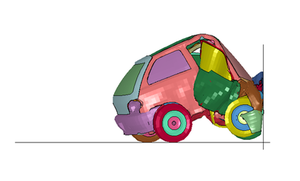LS-DYNA

Screenshot from LS-PrePost showing the results of an LS-DYNA simulation of a Geo Metro impacting a rigid wall at 120 kilometres per hour (75 mph)
|
|
| Developer(s) | LSTC |
|---|---|
| Stable release |
R8.0 / March 2015
|
| Operating system | Microsoft Windows, Linux |
| Type | Computer-aided engineering, Finite Element Analysis |
| License | Proprietary commercial software (1978 DYNA3D Public domain software) |
| Website | http://www.lstc.com/ |
LS-DYNA is an advanced general-purpose multiphysics simulation software package developed by the Livermore Software Technology Corporation (LSTC). While the package continues to contain more and more possibilities for the calculation of many complex, real world problems, its origins and core-competency lie in highly nonlinear transient dynamic finite element analysis (FEA) using explicit time integration. LS-DYNA is used by the automobile, aerospace, construction, military, manufacturing, and bioengineering industries.
LS-DYNA originated from the 3D FEA program DYNA3D, developed by Dr. John O. Hallquist at Lawrence Livermore National Laboratory (LLNL) in 1976. DYNA3D was created in order to simulate the impact of the Full Fusing Option (FUFO) or "Dial-a-yield" nuclear bomb for low altitude release (impact velocity of ~ 40 m/s). At the time, no 3D software was available for simulating impact, and 2D software was inadequate. Though the FUFO bomb was eventually canceled, development of DYNA3D continued. DYNA3D used explicit time integration to study nonlinear dynamic problems, with the original applications being mostly stress analysis of structures undergoing various types of impacts. The program was initially very simple largely due to the lack of adequate computational resources at the time. A two-dimensional version of the same software was developed concurrently. In 1978 the DYNA3D source code was released into the public domain without restrictions after a request from France.
In 1979 a new version of DYNA3D was released which was programmed for optimal performance on the CRAY-1 supercomputers. This new release contained improved sliding interface treatment which was an order of magnitude faster than the previous contact treatment. This version also eliminated structural and higher order solid elements of the first version, while including element-wise integration of the integral difference method developed in 1974.
...
Wikipedia
